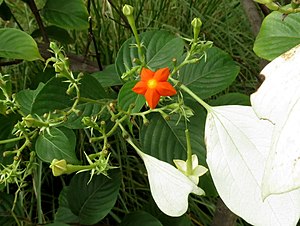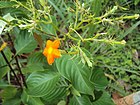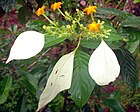Note: This is a project under development. The articles on this wiki are just being initiated and broadly incomplete. You can Help creating new pages.
Difference between revisions of "Mussaenda frondosa"
| Line 8: | Line 8: | ||
==Chemical Composition== | ==Chemical Composition== | ||
| − | Iridoids, flavonoids and triterpenes are the common chemical ingredients distributed in Mussaenda species etc. | + | Iridoids, flavonoids and triterpenes are the common chemical ingredients distributed in Mussaenda species etc.<ref name="Chemical Composition"/> |
==Common names== | ==Common names== | ||
Revision as of 11:33, 25 June 2020
Mussaenda frondosa is the wild mussaenda or dhobi tree. It is a plant of family Rubiaceae. It is a shrub that grows upto 1.5–2 m tall. Like all other Mussaenda species, they have a large prominent white petaloid sepal in their flowers.
Contents
- 1 Uses
- 2 Parts Used
- 3 Chemical Composition
- 4 Common names
- 5 Properties
- 6 Habit
- 7 Identification
- 8 List of Ayurvedic medicine in which the herb is used
- 9 Where to get the saplings
- 10 Mode of Propagation
- 11 How to plant/cultivate
- 12 Commonly seen growing in areas
- 13 Photo Gallery
- 14 References
- 15 External Links
Uses
Jaundice, Cancer, Leprosy, Asthma, Hyperacidity, Fever, Cough.
Parts Used
Chemical Composition
Iridoids, flavonoids and triterpenes are the common chemical ingredients distributed in Mussaenda species etc.[1]
Common names
| Language | Common name |
|---|---|
| Kannada | ಬೆಲ್ಲೊಟ್ಟಿ Bellotti |
| Hindi | Bedina |
| Malayalam | Vellila |
| Tamil | Velli-matantai |
| Telugu | |
| Marathi | NA |
| Gujarathi | NA |
| Punjabi | NA |
| Kashmiri | NA |
| Sanskrit | Shrivati |
| English | Dhobi Tree, Flag bush |
Properties
Reference: Dravya - Substance, Rasa - Taste, Guna - Qualities, Veerya - Potency, Vipaka - Post-digesion effect, Karma - Pharmacological activity, Prabhava - Therepeutics.
Dravya
Rasa
Guna
Veerya
Vipaka
Karma
Prabhava
Habit
Identification
Leaf
| Kind | Shape | Feature |
|---|---|---|
| Simple | Elliptic leaves | 7.5-13.7 long, 4.5-8 cm broad, tip shortly tapering. Base is rounded or tapering into the 2-2.5 cm long stalk. Stipules are twin, lanceshaped. |
Flower
| Type | Size | Color and composition | Stamen | More information |
|---|---|---|---|---|
| Bisexual | Flat-topped clusters | Creamy-yellow elliptic, golden yellow | Actual flowers are 3-4 cm long, tube slender, very hairy. Berries are obovoid, 1-1.3 cm long |
Other features
List of Ayurvedic medicine in which the herb is used
Where to get the saplings
Mode of Propagation
How to plant/cultivate
A plant of subtropical to tropical areas, it is found at elevations up to 1,200 metres in Nepal.[3]
Commonly seen growing in areas
Photo Gallery
References
- ↑ Cite error: Invalid
<ref>tag; no text was provided for refs namedChemical Composition - ↑ Morphology
- ↑ Cultivation Details
Cite error: <ref> tag with name "chemical composition" defined in <references> is not used in prior text.
External Links
- Pages with reference errors
- Ayurvedic Herbs known to be helpful to treat Jaundice
- Ayurvedic Herbs known to be helpful to treat Cancer
- Ayurvedic Herbs known to be helpful to treat Leprosy
- Ayurvedic Herbs known to be helpful to treat Asthma
- Ayurvedic Herbs known to be helpful to treat Hyperacidity
- Ayurvedic Herbs known to be helpful to treat Fever
- Ayurvedic Herbs known to be helpful to treat Cough
- Herbs with Flower used in medicine
- Herbs with Leaves used in medicine
- Herbs with common name in Kannada
- Herbs with common name in Hindi
- Herbs with common name in Malayalam
- Herbs with common name in Tamil
- Herbs with common name in Sanskrit
- Herbs with common name in English
- Habit - Herbs
- Index of Plants which can be propagated by Seeds
- Herbs that are commonly seen in the region of Garden area
- Herbs
- Rubiaceae





